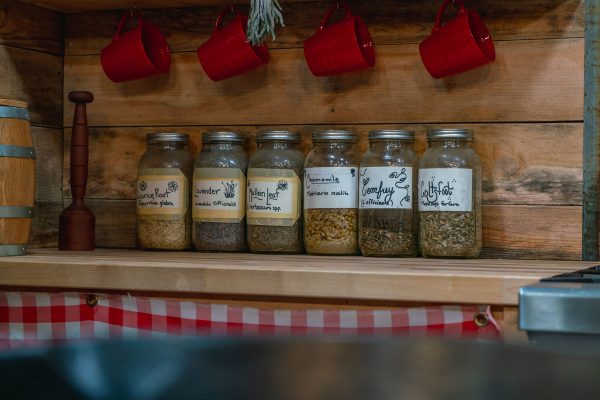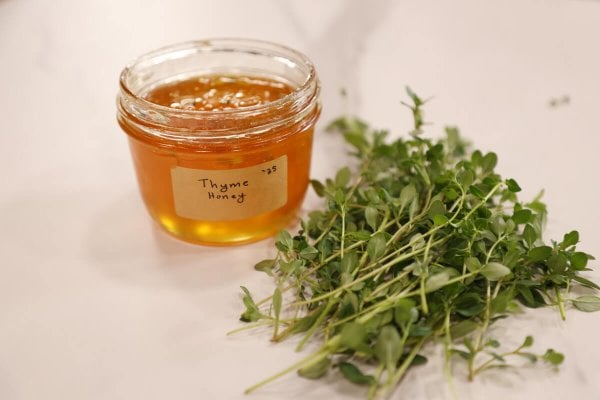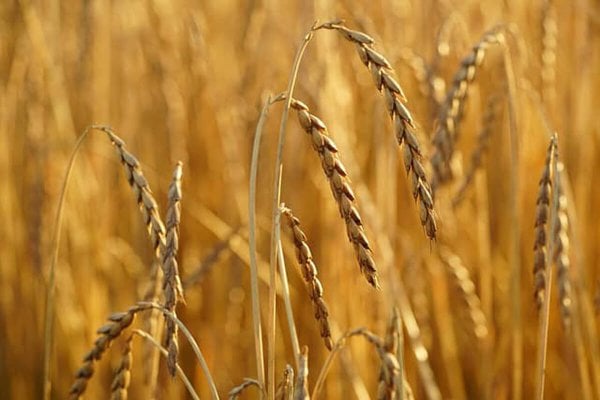




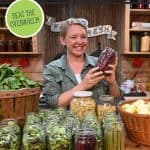
Here are my top preserving day tips for preventing overwhelm on a busy harvest day! It’s easy to see the harvest come in and quickly get overwhelmed at how much preservation has to happen. With these six tips, you can remain calm, stay upbeat and get through the day with joy.
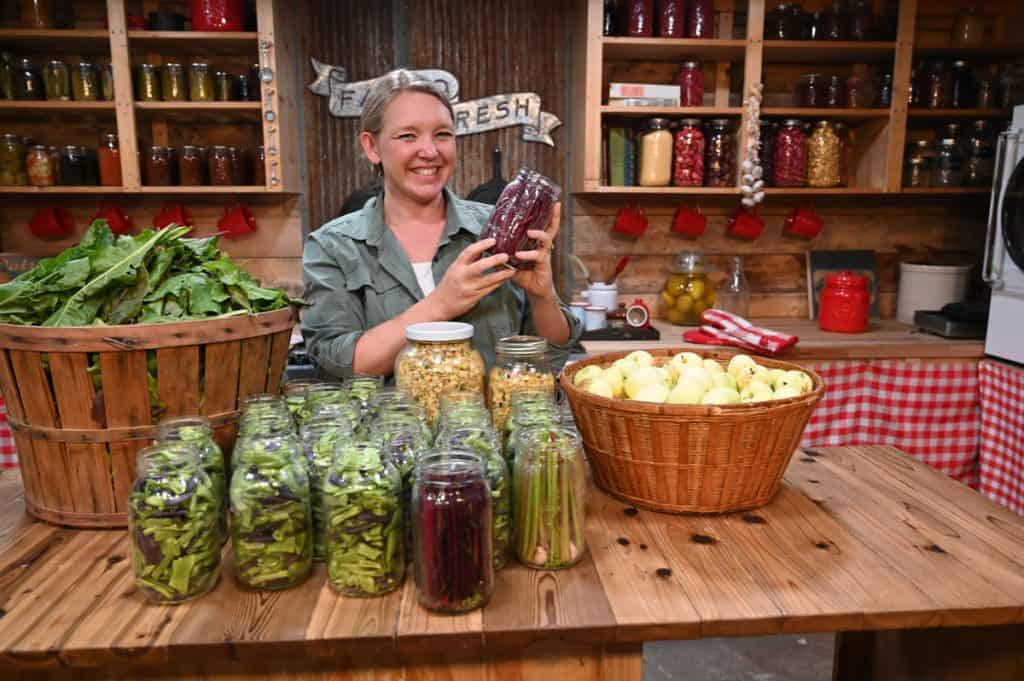
Preparing for the Preservation Season
There are many things I do to prepare for preservation season throughout the year. Here are some other posts that you may find helpful:
- Preserving Year-At-A-Glance
- How to find preservation tools on a budget
- How we prep our pantry for the preserving season
- How to take inventory of your canning supplies
- How we store all of our preserved foods
Below I’m sharing what a typical preservation day looks like in the kitchen. We have a lot of helpers now that the children are growing older, but these tips will help you whether you’ve got helpers or are preserving on your own.
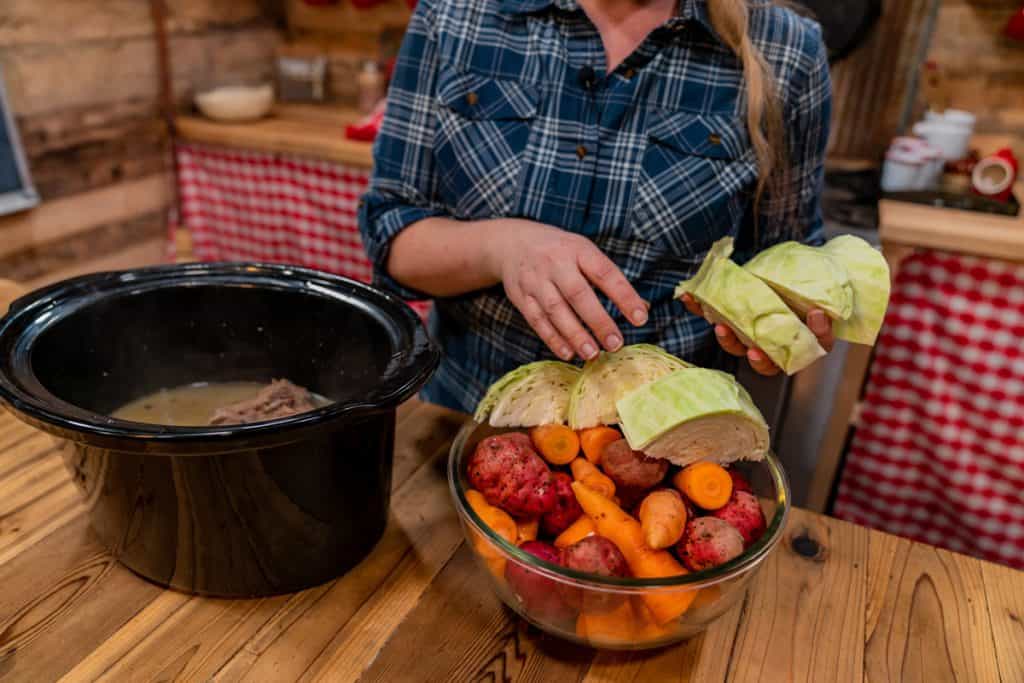
Get Dinner Started Early
My first preserving day tip is to plan dinner ahead of time and, if possible, get it cooking first thing in the morning. Make it something that’s no-fuss and requires very few dishes (or even use paper plates, if possible).
For us, this often looks like a roast that I slow-cook in the crockpot. A few hours before dinner, I’ll toss in some new potatoes, and we’ll have some veggies on the side. Everyone will love this meal after a long day of work.

Start with a Clean Kitchen
You don’t want to have to clean the kitchen before you can even begin preserving the harvest. It’s always best if you can jump right in! So do yourself a favor and, the night before, get that kitchen nice and tidy.
If you didn’t clean your kitchen the night before, clean it up before heading out to the garden to harvest, or before you head to the Farmer’s Market to grab your produce.
Homestead Hack – Clean as you go! As you’re preserving, be sure to clean up as you go! This can either be done by you, a spouse, or a child, but you’ll be much more productive if the kitchen stays as clean as possible as you move from project to project.
Do a Little at a Time
This may not be possible if you’re trying to save your crops from a freeze, but if you’re able, bring in only what you can process at the same time.
For instance, make up a batch of fermenting brine and pack your homemade sauerkraut or fermented ginger carrots as you slice up each cabbage or batch of carrots. This will be easier than bringing in every head of lettuce and all carrots at once.
Process as you go, and the day won’t seem quite as overwhelming.
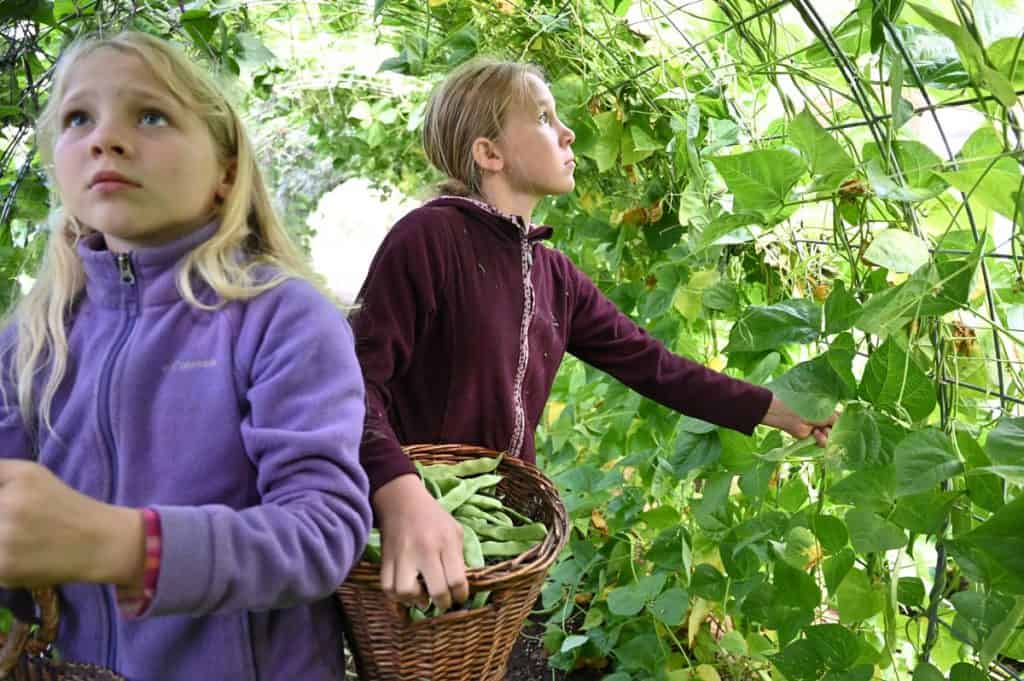
Pick First Thing in the Morning
Get out to the garden or to the Farmer’s Market as early as you can. The reason for this is that the sugars are going to be at their height in your fruit and vegetables first thing in the morning.
You want to be picking your produce at their sweetest and their best, then bringing them into the house and keeping them cool so they don’t start wilting before you have a chance to preserve them.
This is especially true of cucumbers! So start with your homemade pickles first!

Utilize Everything in the Kitchen
When you’re working with a lot of produce, be sure you’re utilizing all of your appliances, all the preservation methods, and all the people available in your home.
Get that food processor, blender, mixer, dehydrator, and freeze dryer working for you. Put all the extra hands to work harvesting, washing, cleaning, and tidying up behind you.

Include Your Children
This goes along with tip #4… be sure to get your children involved, it’s so great for them! There is something kids of all ages can help with. They can pick up fruit off the ground, clean up spills, fetch jars, snap beans, or slice veggies.
If they’re older, teach them how to preserve, how to use the pressure canner or water bath canner. Get them stirring or blending the fruit puree for homemade fruit leather. If nothing else, make sure there’s always someone washing dishes to help keep an empty sink.
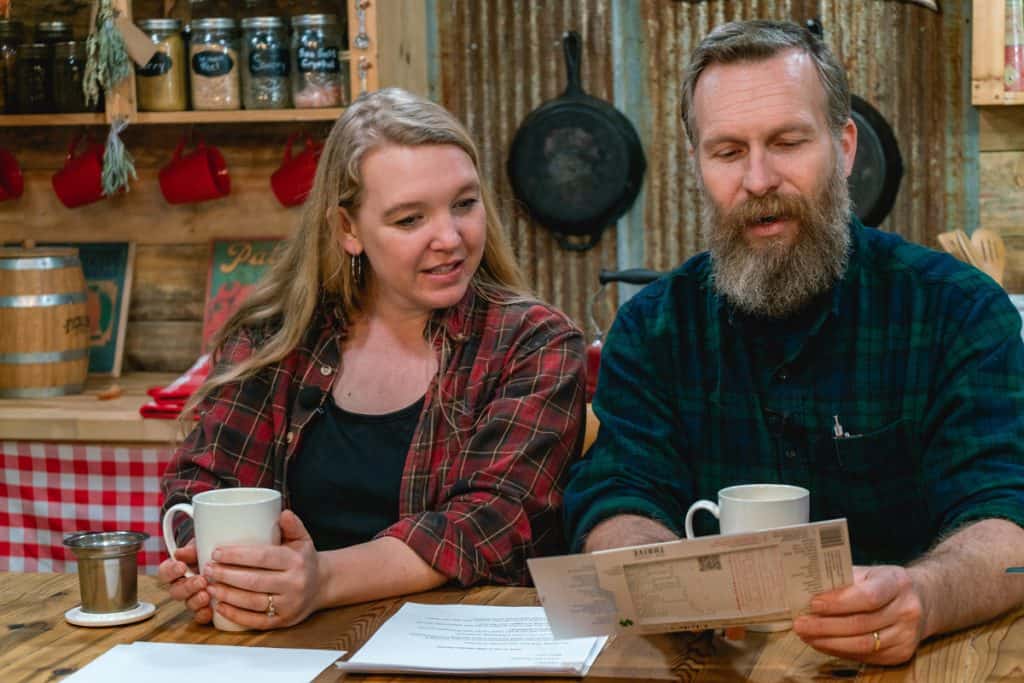
Use a Planner
Planning is key! Hopefully your garden was planned to harvest at different times instead of all at once. You can have several big harvest days instead of just one or two.
Clyde’s Garden Planner is a great tool for knowing when to plant and estimating when your crops will be ready to harvest. Use code “HOMESTEADINGFAMILY.COM” at checkout for a discount on your planner!

Remember Why You’re Doing This
It’s easy to get overwhelmed on a busy preservation day and to lose sight of why you’re doing this. But try to remember how thankful you’ll be when your pantry shelves are lined with healthy, home-grown, and home-preserved food.
Put on some great music, and remember to have fun! Maybe even do some dancing, get your kids laughing, and enjoy your day together. If you’re having fun it will make your work go a lot faster and your day much more enjoyable.
Now go ahead and start building up those food stores for winter!
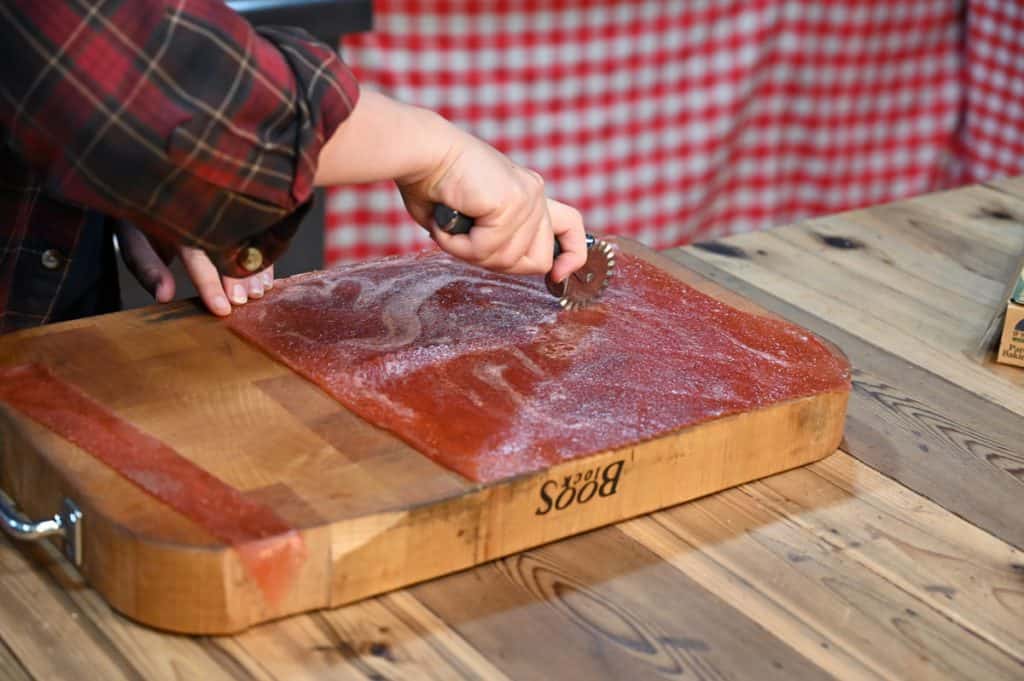
Other Topics Mentioned in the Pantry Chat…
- Plums, Plum Leather & Jelly – What we do with the abundance of our plums, including our favorite fruit leather recipe and plum jelly recipe (+time-saving trick).
- Homeschooling – It’s that time of year to get back to the books… learn about getting started with homeschooling here! Educating children through homesteading has more benefits than you may know.
- Annual Clothing Switch – Trade out those stored clothing boxes and bring out the warm stuff! Need some ideas on affordable clothing?
- Soap Challenge in the Homestead Kitchen Membership – If you’re not a member of the Homestead Kitchen, you can get on the waitlist now. You’ll be the first to be notified when our doors open for enrollment again! We do all kinds of fun challenges throughout the year.
- FREE 4-Day Canning Workshop – If you’re new to canning or want a refresher on basic canning procedures and safety, you’ll want to join me for my free Meals On Your Shelf Workshop, where I’ll teach you how to make eight jars of your own convenience meals!
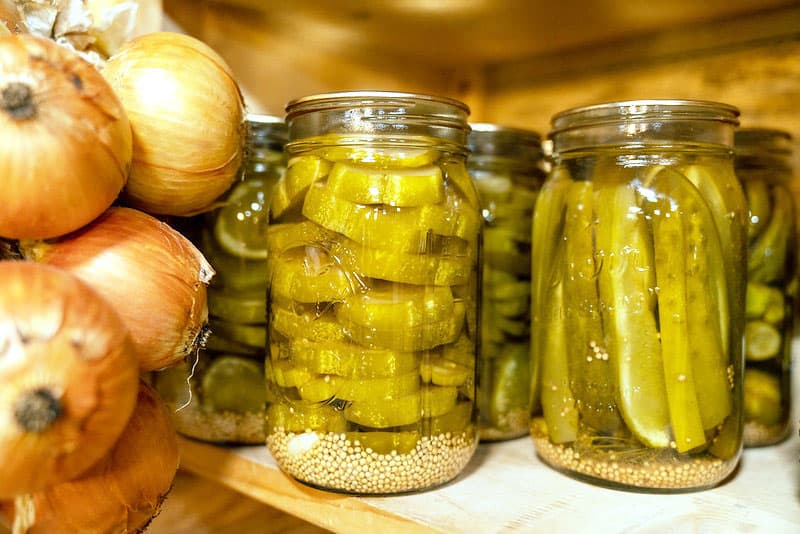
More Posts You May Enjoy
- Easiest Tomato Preservation Method
- Preserving Herbs in Salt – Two Ways
- How Full Should My Canner Be When I’m Canning?
- How to Get Ready for Canning Season
- Where to Find Canning Supplies When There’s a Shortage
- Pressure Canning Tips (+ 5 Common Mistakes to Avoid)
- How to Get Ready for Canning Season
- Pumpkin Fruit Leather Recipe
Josh: Hey, guys. This is Josh.
Carolyn: And Carolyn.
Josh: With Homesteading Family and welcome to this week's episode of the Pantry Chat, Food for Thought.
Carolyn: This week we are talking about how to handle a busy harvest season with lots of things coming in.
Josh: That's right. If you've worked hard to grow all this food, that's challenging, but sometimes the more challenging part is how to handle it all coming in, especially it all comes in kind of at the same time.
Carolyn: It definitely can and that can start feeling really overwhelming and kind of stressful, especially if you watch things start to go bad before you can get to them.
Josh: Yeah, it's like, "Nah, I worked hard for that. What do I do?"
Carolyn: We're going to be covering some of the tips and tricks that we use around here to make sure that we get the most out of every bit of food that we have brought in.
Josh: All right. Good.
But before that, we are going to catch up a little bit, what's going on around the homestead, and answer one of your questions. So what is going on with you?
Carolyn: The harvest.
Josh: Oh, boy.
Carolyn: We're right here, handling the harvest. So today's episode is like notes to myself, remember how to handle all this. Yesterday we canned 90... 90. 90 pints of plum jelly and did a dehydrator filled with plum leather.
Josh: And there are still plums all over the place.
Carolyn: And there are still two full bushel crates of plums that need to get done.
Josh: What are you going to do? I'm voting for more fruit leathers. I love the fruit leathers.
Carolyn: Fruit leathers are good.
Josh: Very, very good.
Carolyn: Yeah, the fruit leathers are good.
We really use the plum jelly as kind of our everyday standard jelly, around the house. That's what goes on peanut butter and jelly sandwiches. That's what we grab if we're making thumbprint cookies or jam bars or jelly bars or with oatmeal.
So I might go with more of the... I'll probably do both. And we'll actually talk about some of that here. It's important to make sure you're using all your different methods and employing everything that you can. But this isn't even talking about the fact that we haven't even picked the prune tree yet, the Italian prune tree.
Josh: Yeah. Thankfully, it's a little younger tree, so it's not as big. We have this plum tree that just... It's happy. It's great. I mean, it's a good reminder to always be smiling, because this tree, no matter what the year is like, this tree is happy and productive.
Carolyn: It just puts out plums and it's not even that big. And when you look at it in the beginning of the season, every year I go, "Oh, we're not going to get that many plums," because they kind of hide [inaudible].
Josh: It never looks like it's going to... It doesn't even look like it's flowering that much.
Carolyn: It doesn't. And then you go start picking and you're like box, after box, after box. Anyways. So we're doing a lot of that.
Josh: We'll get back to that.
But real quick, since we got on the plums, because people are going to ask, I guarantee you, what variety it is, and I don't know what variety it is. The plums look like an Italian prune. They look similar to that. Not exactly the same.
Carolyn: Kind of.
Josh: Well, but they look more like that, than a regular round plum that a lot of people think of.
Carolyn: They're pretty round.
Josh: Yeah, they look a lot like a...
Carolyn: You think so? Okay.
Josh: Yeah. Okay. I'm not agreeing, but anyways, they're kind of that color. They have a very similar color to the Italian prunes and they start to shape that way. They're not as elongated, but that's the best hint we have for you. The tree was here when we got here and we don't know what it is. So can't help you with that.
Carolyn: It's definitely a purple plum with a green flesh on the inside.
Josh: Yes.
Carolyn: We can tell you that much.
Josh: Yep.
Carolyn: It's not a red plum. It's not any of the other [inaudible].
Josh: Yeah, it's a little different than your standard fresh eating plum. In fact, they're not as good fresh. They're wonderful jelly and wonderful fruit leathers. They're okay right when they're at their prime, they're pretty good, right at the peak of rightness, but they're not as good as some other plums [inaudible].
Carolyn: Any of you guys are hearing that and you're like, "Oh, I know exactly what kind of plum that is," let us know.
Josh: Yeah,
Carolyn: Because we'd love to know. I don't think any of us have ever researched it.
Josh: I've never really researched it. It's just been there, but don't know what it is.
Carolyn: It's doing its thing.
Josh: So besides plums, you're just plum plummy.
Carolyn: I am very plummy. So is the kitchen floor.
Josh: Along with everybody else and a lot of people. It takes a lot to get that much done in the day.
What else is... There's a lot more than that going on in there. That's just the start.
Carolyn: A lot of preserving happening. A lot of different types of preserving happening right now.
And then, of course, on top of that, we're getting to the school year. So we're getting all ready to start the homeschool year. We start a little later than a lot of people do.
Josh: Because of harvest season, generally. We've learned to just quit fighting it and we're all with harvest season.
Carolyn: Go with it. We can stick the rest of the school into different parts of the year.
And a lot of times we have long, dark winter days where we can double up on school and get more done. So we catch up at a different point but we are getting ready to start that.
And then drum roll, we've got the big semi-annual clothing switch coming.
Josh: Oh, right. I didn't know what you were drum rolling but yeah, right. That is a biggie though. I got to say.
Carolyn: Yeah.
Josh: You didn't stress too much this spring. You handled that very, very well And I think maybe people are getting a little older and systems are getting refined. And the whole thing is getting better. I'm not afraid to come in the house at the end of the day.
Carolyn: You have to bring me Chinese takeout or some offering, to soothe me back down after that day, usually.
We did realize that this year, though, baby is due before the spring clothing switch. And so we need to, while we're up there dealing in the attic, dealing with all of these different clothing boxes, we need to locate baby boxes and get them, at least the newborns to the front, which we don't know if it's a boy or a girl. So we're going to have to pull out a couple boxes here.
Josh: You better figure a day in for attic organization. I can tell you that. Part of the project this year, especially with that thought.
Carolyn: I started worrying about that.
Josh: Especially with that thought, yeah.
Carolyn: We may have to just pull all the boxes out and put them back in, in order.
Josh: I'm thinking you may.
Carolyn: That's kind of scary.
Josh: I didn't catch that part of it yet. And so I would definitely recommend that you add that into the equation.
Carolyn: So anyways, all of those things are keeping me hopping and then we're doing a soap challenge inside the membership. A lot of you guys, if you're in the membership, you're in there already making soap and that's really exciting. We've got soap sitting back here, behind me, finishing their curing.
And then if you are not in the membership, you're kind of missing out on this round. But the classes, the class will still be in the membership for you. So even if you miss the challenge where we're doing it all together, if you want to join in the next time we open up the membership, it'll be there, and you can go through it by yourself.
Josh: Cool. You're also doing a webinar? Free training?
Carolyn: Yes.
Josh: Free training?
Carolyn: Yeah. Canning.
Josh: Tomorrow?
Carolyn: Tomorrow. So there'll be a link below for you. So if you want to jump in on that and get into a live... It's a live free training. You get to come hang out. We have a lot of fun, actually, on the webinars and the trainings.
Josh: I used to always be back there, backing her up and running the IT and the chat.
Carolyn: Tech side of it all.
Josh: And jumping in the chat with you guys. And now with STS going, I've had to turn my attention elsewhere, but you've got a good team. You got Robin and Annie back there, backing you up.
Carolyn: Yep. Lots of good help.
Josh: Now, I do got to ask about baby. How are you and how's baby? People are going to want to know you're...
Carolyn: I'm doing good. Well into my second trimester and feeling good and tired, but it's also harvest season so it's a little hard to say what am I tired from?
Josh: All of it.
Carolyn: Probably all put together.
But yeah, feeling good.
Josh: Good.
Carolyn: Doing good. How about you? What have you been up to?
Josh: Wow. What have I been up to? There's so many projects we're trying to get wrapped up. We're doing an addition on the barn.
And I got to say, I'm managing that more than doing a lot of it, because I've been working on Homesteading Family and School of Traditional Skills in the background. Mostly School of Traditional Skills, but the trying to rush and get the barn roof up on the addition. Brought in, oh let's see, 24 tons of hay.
And thankful now, to have this additional barn roof on it, so we're not working under tarps or not having it like the barn breezeway packed full where we can hardly get around in there all winter, because there are other things that we need to do in the winter.
So getting that in, getting ready to go get grain in. And you know what? I am bulk buying. We always bulk buy grain, but I'm actually planning a year ahead. I'm even going to buy my chicken grower right now and have it. I'm concerned about where the prices are going to go.
Carolyn: Yeah.
Josh: So I'm trying to make sure we're actually stocked up even for next year's meat chickens in the field and we're going to do some pastured pork, probably. I'm getting ready for that now.
Carolyn: Good.
Josh: We've created the roof space for it and so I want to get ahead of these inflationary pressures a little bit, because I think they're going to get worse.
So there's a lot of planning like that. We've got a huge pile of firewood. I just bought logs this year. It was too busy with all the traveling and everything, to cut our own trees. And so we've got two, if not three, years' worth of logs. So we rent this great machine that's a firewood log processor and we can do about 10 cords a day, split and stack.
Carolyn: This machine is cool because it takes the full log on it and it does all the parts of the [inaudible].
Josh: Yeah, why don't you run it? You run it at one guy. So I got one guy. Usually Tristan's running the tractor, he's loading the machine, and then I'm running and you conveyor belt it to wherever you want, and can make a pile or whatever. And so that's huge.
That's another one I'm getting ahead on, a little bit. I've always tried to keep us at least two years ahead on firewood.
Since we moved here, we haven't had that. And so I'm finally getting to that step where we'll be at least two. I wouldn't be surprised if a little bit more.
But again, just in our area, a lot more people are moving here. They're buying more firewood. Everything is getting more expensive.
So working to get ahead of that and then hopefully with being ahead a little bit, we can give back. We have plenty of timber to cut for firewood ourselves. But you got to get into a cycle of getting it down, curing it, letting it dry before you get it into the house.
So these are all kind of fall prepping, harvesting, getting ready. We're shearing the sheep here in a couple days. We have somebody come in to do that. That is hard on the back and that's why we're not doing that ourselves.
Carolyn: And we still have butchering coming up.
Josh: We still have butchering sheep and pigs we're going to do ourselves this year and that'll be in November. So that's a little ways out.
And getting ready for winter, really. Starting to think about shutting water systems down. Helping manage the garden and the harvest coming in. The girls are getting everything in and we've got a little bit more to do there.
Carolyn: Yeah.
Josh: And prep the garden soon. So that's coming up.
So, a lot.
Carolyn: There you go.
Josh: It's a busy, busy time.
Carolyn: Lots of pieces.
Josh: Lots going on. Yep.
Carolyn: Yeah. Good.
Let's get to our question of the day.
Josh: That's me. But I can't get into there.
Carolyn: That's me. There we go.
Josh: Good. And so yeah, let's get in the question of the day, so we can get on topic.
Okay, Sir Smurfalot. All right. What's up, Sir Smurfalot?
On freeze dryer review video, that you did the one-year freeze dryer review.
Carolyn: Yes.
Josh: I notice you can your food after freeze drying. How do you seal your jars?
Carolyn: So I store my freeze dried food in jars, so they're not really canned, technically, because canned would refer to it being processed after the food is in there and sealed.
So it's actually just sealed or stored in the jars. So it's kind of a different thing. It may seem like splitting hairs and I'm giving a grammar lesson here, but there's it's important to know when it gets into food safety, that there is a major difference there.
But what I'm doing is I'm taking the food that is freeze dried and I'm taking it while it's still warm. So I don't have any ability to suck up anymore food.
This is important because freeze dried food is usually like 97 to 99% dehydrated, if I'm remembering the numbers correctly. That's in completely safe range to store in an airless environment.
So I'm taking that, getting them into a jar and then I'm using a vacuum sealer to seal that jar so it's not been processed, but the moisture content is so low, that there is no chance of forming any sort of botulism in there.
Josh: Yeah.
Carolyn: Now you do have to make sure that your food is really well dehydrated, all the way through. Because sometimes if you have a freeze dryer, or some of you guys know that if you run things through one round, there is a chance that some of the foods in the middle of the tray, in the middle of the freezer, could not be done all the way. And there could be a little bit of moisture in it. You want to make sure to avoid that. So make sure you're always testing all the food on those trays, making sure there's no moisture left.
If there is, stick it back in and run it in the freezer dryer.
Josh: Yeah, run it a second time.
Carolyn: Let me be real clear, a second time. Same thing with dehydrated foods. You can do that. Dehydrated foods are usually done at about the 95% dehydration level. Again, that is totally safe for sealing in jars, in a vacuum sealed environment.
Josh: And that freeze dried food has been processed. So there is no reason to do go through all the extra effort to can, like take it through a canning process. That's a lot of energy, a lot of time.
You do want to get it sealed though, because that food will take on moisture over time and go bad. So using the vacuum seal, or I think a lot of people use the Mylar bags.
Carolyn: Yeah, you can use that, too.
Josh: They either vacuum seal those, or they put the little packets in them.
Carolyn: Little oxygen [inaudible].
Josh: Little oxygen packets. So you do want to do something to seal it, if you're going to have it last on the shelf for a year or two or five or a hundred. Some people want it to last that long.
Carolyn: It'll be there.
Josh: That's good. Yeah, absolutely. Very cool.
Carolyn: Good.
Josh: All right, so we are talking about handling the harvest.
Carolyn: Yes.
Josh: And that can be a real challenge. Right now, Carolyn's got, not only plums, but green beans, tons of mushrooms, cheese, dairy. We still got a lot of dairy coming in. It's starting to slow down as it cools off. And that's...
Carolyn: Celery, bell peppers.
Josh: Oh, yeah. Celery is coming in today. Bell peppers are on the list.
Carolyn: Onions, garlic. Still getting our hands [inaudible] bringing the garlic in.
Josh: Yeah, apples coming. Italian prunes coming. Lot going on. So it's a lot to handle and there's definitely a lot of tips and tricks. So hopefully, this will be helpful to you.
Let's dive right into your first tip, is to do a little at a time. Expound.
Carolyn: So my first two tips are going to seem like they're kind of opposing views here, but I think they need to be combined well.
If you're getting little bits of harvest, bring them right in and preserve them right away. There are a lot of things that you can do with really small batches of stuff. Fermenting comes to mind. Fermenting is one of the fastest methods we have for preserving food.
Josh: Low energy and easy, too.
Carolyn: You can make up a big batch of fermenting brine and you can keep it on your counter and just pour it into your jars. As you get food, pack it into a jar, pour it right in. So whether we're talking tomatoes, we're talking cucumbers for pickles, add a few spices in there, pack that jar, pour the brain over it, put a weight on top, you're good to go.
Josh: Green beans. Green beans are ones that sometimes they kind of trickle, they'll have these big prolific batches and you want to can them, or you've even been freeze drying them, but then sometimes they're just trickling in a little bit.
Carolyn: Yeah.
Josh: They're wonderful.
Carolyn: They really are. And so make sure that you're kind of processing as you go, as well as using as you go. Right?
Josh: Yeah.
Carolyn: And I actually have a video coming out on how to take these little bits and odds and ins of stuff coming out of the garden and use them for meals and just make sure you keep using them up.
So every day do a little bit.
Josh: Yep.
Carolyn: Something small. It doesn't have to be huge.
Josh: Very cool. So the opposite of that is having planned, big harvest days, like a major focus.
Carolyn: And a lot of times this'll be like a Saturday, especially if you're working, or you've got kids in school, or whatever it is. But this is the time where you have that apple tree is ripe and ready for picking. The plum tree is ready and you've got a big jam day. Or maybe you have a whole bunch of little bits of stuff and you've just got to do something with all of it and get it kind of cleared out before the next little bits come in.
Josh: Or the green beans or the corn. Or if you're growing like determinate tomatoes, trying to get a whole bunch in at once, which is a good strategy.
Carolyn: It really is, yeah.
Josh: Yeah.
Carolyn: And so some of the things that you want to do with these big days, I have a couple different tips that just make it totally doable.
Step number one, prep everything you can the night before. If you're canning, get your jars ready the day before. If you're using your dehydrator, get your dehydrated sheets all ready. Whatever it is you're doing, try and be prepped the day before with the equipment. Stock pots are clean, ready to go, things like that.
Always, always start your day with a meal in your Crockpot or your Instant Pot. You're not going to want to cook dinner at the end of this day. You're going to be tired. You're going to have had a dirty kitchen all day and you're not going to want to make a mess out of it again, just to cook dinner.
The first thing you do on a big harvest day and a big preserving day, get dinner into a Crockpot, a stock pot, an Instant Pot, whatever it is that you use. Make a casserole first thing, and have it in the fridge, waiting for you to just pop it into the oven. Whatever your method is, get that done first. Lunch and dinner, figure it out. Get it ready.
And it can be simple. A lot of times we'll do rice and beans for a big day. We did that, when we were doing all those plums, the other day. We just had rice and beans in the Crockpot, ready to go. And we've got some salsa ready to go and a little bit of shredded cheese and it makes for a great meal for a lot of people who are here helping.
Josh: Good. Well, thinking of planning and you see planning is key.
Carolyn: Yeah.
Josh: This is going backwards a little bit, or maybe forwards for you to next year, but planning your garden, you can plan certain things to harvest a little at a time. And you know they're going to trickle in and trickle through.
You can plan for other things, that you're going to have some major harvest days. You can plan that in your planting schedule by succession planting, or by trying to get strategic on when you actually plant your beans or your corn. So you know the bulk of them are going to be ready about here. So I want to get this done mid-September or something. And as it gets closer you can pick a day, right?
Carolyn: Yeah.
Josh: But that planning, for these two tips that Carolyn's given you, in the garden at the beginning of your year, or ideally in winter times when you're doing your planning, can really, really help in hitting your points to both of these strategies.
Carolyn: Yeah, absolutely. And I think that's important because we kind of get in this mindset that, oh, what's the first planting day for main crop garden?
Josh: Mm-hmm.
Carolyn: Put it all in, right then.
Josh: Right.
Carolyn: That doesn't always... I mean you don't want to bring it all out on the exact same day.
Josh: Well, that's often what happens, not everything matures at the same time, obviously. But there are a lot of things that often end up maturing at the same time that way. And so a little bit of planning, a little bit of understanding how long it takes to get from seed to harvest, and then if you can stagger things a couple weeks, that can all help.
Carolyn: So the actual practical side of how you do that, is get yourself a garden planner. I don't know if we have a Clyde's?
Josh: We have Clyde's. Clyde's Garden Planner, we'll link to it down below.
Carolyn: Yeah.
Josh: Get them now. They're not expensive and they're very, very helpful.
Carolyn: Yeah, a couple dollars and it will show you how many days to maturity. Obviously, that's a rough estimate. It's based off of somebody else's garden. But it's going to give you a basic idea to how long it's going to take you to be harvesting that.
Josh: There are also some good digital planners and I can't think of the one. I have one. I haven't used it a whole lot more, because I haven't had time to learn it. But for those of you that are inclined that way, I'll try to find it and get a link down below there.
Carolyn: Great.
Josh: There's some good digital planners, if you like that kind of thing as well.
Carolyn: Okay.
Josh: But moving on. Okay, expand on this one. Use your help. What do you mean by that?
Carolyn: Sometimes we get into this mindset, I think especially if your help is under 18. You've got kids in the house. It's easy to get this, I'm going to get the kids out of the way so I can get the work done. That is not profitable in the long run.
You need to use your help. Use the people you have available. It is amazing how much little kids can do to help you. They can wash stuff in the sink, they can put stuff on a pan, they can run stuff, if they're a little bit older, through the food processor and shred it while you're doing another step.
Josh: And string and snap green beans.
Carolyn: Yeah. And a lot of times we'll put on an audio book for the whole family, sit around the table and snap those green beans and all those little hands working gets a lot done.
So make sure you're getting everybody available to you, to jump in and help. Especially if they're going to eat the food. You guys, they're going to eat the food. There's nothing wrong with them doing the work to help preserve it.
Josh: Right. And it actually is very bonding. People often ask us, how do we train the kids? Well, involving them in a positive way is part of that training and it actually becomes bonding and they see the value in that.
So yeah, they don't always want to do it at the time. But little things like an audio book, having some form of maybe something to talk about, or singing together. You figure out what works for your family. But there's a lot of things you can do to make that work a good experience. And then it becomes a bonding experience, even though it's work.
I think the other one you were going to talk about, was get getting friends, the neighbors involved sometimes, and sharing the harvest a little bit.
Carolyn: Absolutely.
Josh: And maybe giving somebody some harvest, or teaching somebody, if you're a little further along. Maybe somebody else trying to get started.
Carolyn: There are a lot of people out there, who are looking to learn these exact things.
Josh: Yeah.
Carolyn: And so they're really willing, a lot of times, to come in and to help you work, just to be able to have the experience and learn it.
So ask around. Do you want to help? If you happen to mention, when you're at church, "Oh, yeah. I've got to can a bunch of green beans this weekend," and somebody sounds interested, invite them to come over and to join you and send them home with a couple of cans of green beans.
But bring in people. And yes, it's the same thing. I don't want to say working with your friends is like working with your children and that you're training them, but there is that element that you may be working with somebody who doesn't have a lot of experience doing what they're doing. Just start them in one station and then move them to a next station. And I actually have a whole video coming out, about managing these big days and setting up stations and then rotating people through them, because it can be hard.
It's a skill we haven't really maintained in modern culture, is how to work together in a group. And they can be great fun days and you can get a lot of work done. So make sure you're bringing people in and getting them to help.
Josh: And if I can add one to your list here, that's talking around a little bit, but both with managing people and managing the stuff, is systems.
Carolyn: Yeah.
Josh: And this is something that's thematic and what we talk about is planning and systems. Those two things are very, very big.
Carolyn: Right.
Josh: And so you to manage the people in the way you're talking about, you need to have a system. To process the food well, you need to have a system, starts from the day before and planning and all that, but you're having a system, you're not just kind of getting up and going at it one day. That is huge.
Carolyn: Right.
Josh: Yeah.
Carolyn: It really is. And that takes thinking through the different steps before you start and saying, "Okay, what needs to happen? Here are all the different steps of the process. How can I set this up to run well?"
Josh: Yeah.
Carolyn: Right? That's kind of the steps to creating that system.
Josh: Yeah. Good. Next on your list is, use your machines and tools, the things that you have.
Carolyn: Yes. These are your servants. We don't have servants in modern day life here.
Josh: We have tools. We have machinery, does that work.
Carolyn: We have machines that do the work of a lot of people. Use them. That's why you have them in your kitchen. Use your food processor. Use your dicer kits that come with your food processor or buy the attachment. Use your blender. Make sure you're using the tools that you have on your hand to make things go faster.
Sometimes if you're doing a really small batch, it's faster to do it by hand than it is to clean the machine afterwards. I do know that.
Josh: Yeah.
Carolyn: But when you get into these big days, pull them out and get them fired up and get them working, because that's where you're really going to get a lot done and save a lot of time.
Josh: It really is. And a lot of us want to know the old skills. And I use the butter example a lot. It's great to know how to churn butter in an old butter churn or shake it in a jar and they're great. There may be a time when that's very valuable to use, too.
But when it comes to modern homestead and living in today's world, use the power tools that you have. And it makes it so much more doable and efficient and pleasurable.
Carolyn: Yeah, it really does. It's really important.
Josh: I'd wanted to add to that, too, to make sure you're, you're checking your machines ahead of time. You're maintaining them. You're cleaning them. You're sharpening your knives. Part of your system beforehand.
It's no fun to get everything out the day of, have a big day planned, and you find the machine is gummed up, or maybe it got put away so dirty, it has to be cleaned. But now you've got stuff coming on.
So part of your system, part of your plan, maintain your tools and make sure they're ready before you get to that harvest day.
Carolyn: Absolutely. That's a good one. Sharpen the knives. You said that before.
Josh: Yes.
Carolyn: Earlier, when we were talking. Make sure your knives are sharp. That's an ongoing problem for me, but I'm working on it.
Josh: Well, it's a challenge. You got a lot of people in house, a lot of stuff going on. But a dull knife is actually a lot more dangerous than a sharp knife. Besides less-
Carolyn: And a lot slower.
Josh: ... Yeah. And a lot slower. So okay, use all the methods. What do you mean use all the methods?
Carolyn: Use all your different methods of preserving. Don't get stuck and just like, "I'm going to can the whole harvest." You've got fermenting. You've got dehydrating. You've got canning. You've got freeze drying, if you have that option. You have just plain old freezing. There are so many root cellaring or common storage, where you're curing it in one way or another and getting it tucked off to the side. Make sure you're using all of those methods.
And I like to, when I'm doing a lot and there's a lot going on, first thing I want to do in the morning, deal with my freeze dryer and my dehydrator, because once those are full, those are just going to work away while I'm doing my thing. They don't need me watching them.
And so make sure that you're always getting those machines going first. And then you go into the more labor intensive, like, "I have to be there." Get your canning done after that.
And then fermenting I love, because it's like last minute, on the evenings, on the edges. Quick, let's just ferment that thing. And so you can throw that in, all over the place.
But make sure you're starting your day by getting those long running, non-watched machines going.
Or the methods. You can absolutely dehydrate in your oven on a low temperature, or out in the sunshine, if you have a dry, non-humid environment that's sunny, with some good airflow. Absolutely same. Deal with those first thing in the morning. Get those going and then go into your other methods of preservation.
Josh: Yeah. Very good. All righty. Clean before and after.
Carolyn: This is key. Don't start trying to do a preserving day with a dirty kitchen. You need your counter space. You need your dishes done. You need all your pots clean and ready to go. It creates so much frustration if you walk into the kitchen for a day like this, and you're trying to do something, and oh yeah, that spoon is over in the sink and it's dirty from last night's dinner or from this morning's breakfast Whatever it is that's going on, get your kitchen clean. Clean your counters. And in between projects, wipe your counters down again. It saves a lot of work in the long run, if you're just working as clean as possible, which is kind of, some days it's a joke. 90 jars, pint jars of plum jam, like you want to talk? I bet you the ceiling's sticky after that. Everything's sticky. There's jam everywhere.
But stop in between, wherever you can. As soon as there's counter space, just wipe it and just keep wiping.
Josh: Yeah.
Carolyn: And that's good.
But at the end of the day, get it all the way clean. I know you're tired. I know you're frustrated. And at that point, if you've had little kids helping you, you may have little kids with jam in their hair, or whatever it is that's going on, but clean all the way.
And then tomorrow morning, remember you've got your dinner already. So it's that going to be easy.
Josh: You've got a casserole or a canned meal, like Carolyn teaches or something.
Carolyn: If you're especially tired, pull out the paper plates. Give yourself a little break. If you've done a huge day and you're like, "I don't want to do anything," that's fine. You can do that occasionally. Not all preserving days are going to be that bad, but make it easy.
But then in the morning, you're going to come into your kitchen, and you're going to have all these jars of things. And your kitchen's going to be clean. And your dehydrator is going to be ready for you. And it's going to be a very rewarding feeling, when you walk in the next day, instead of a, oh, my goodness. And now it's all dried on and sticky and a disaster.
So take the time, even if you're tired, get the kitchen cleaned up behind you.
Josh: Good stuff. The harvest is good, good stuff. But it takes some work, to get it all in.
Carolyn: It does. It is work, one way or another.
Josh: So we help hope that really helps and helps you get through the harvest time, and helps you enjoy it, and even have some good times with family. It's a good life.
Carolyn: Yeah, very good. It's very worthwhile, even for all the work.
Josh: Yeah. It's been great hanging with you guys and we will see you soon.
Carolyn: Goodbye.
Josh: Bye.
Sign up to receive email updates
Enter your name and email address below and I'll send you periodic updates about the podcast.











